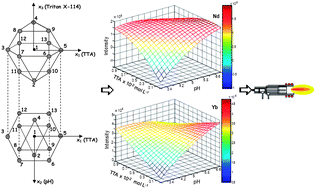Multivariate optimization for cloud point extraction and determination of lanthanides†
Abstract
A cloud point extraction (CPE) method is proposed for pre-concentration of lanthanides and subsequent determination using inductively coupled plasma optical emission spectrometry (ICP OES). Octylphenoxypolyethoxyethanol (Triton X-114) and 1-(2-thenoyl)-3,3,3-trifluoraceton (TTA) are used as surfactant and complexant of the lanthanides, respectively. A three-factor Doehlert matrix design with seven, five, and three levels is used to optimize the TTA and Triton X-114 concentration and the pH of the solution, respectively. The better conditions for pre-concentration are 0.001 to 0.005 mol L−1 TTA, 0.05 to 0.3% (m/v) Triton X-114 and pH from 5.5 to 7.0. Under these conditions, the fourteen naturally occurring lanthanide elements can be pre-concentrated together and then measured. The conditions established were pH 6.0 and 0.175 (m/v) Triton X-114 for all investigated elements; 0.005 mol L−1 TTA for Sm, Eu, Gd, Tb, Ho, Yb and Lu; and 0.001 mol L−1 TTA for La, Ce, Pr, Nd, Dy, Er and Tm. By using axially viewed plasma and pneumatic nebulization/aerosol desolvation, the limits of detection were 0.028, 0.099, 0.103, 0.020, 0.018, 0.014, 0.013, 0.047, 0.015, 0.009, 0.022, 0.003, 0.002 and 0.002 μg L−1 for La, Ce, Pr, Nd, Sm, Eu, Gd, Tb, Dy, Ho, Er, Tm, Yb and Lu, respectively. The proposed method was applied for lanthanides determination in mineral water, river water and reference water.


 Please wait while we load your content...
Please wait while we load your content...